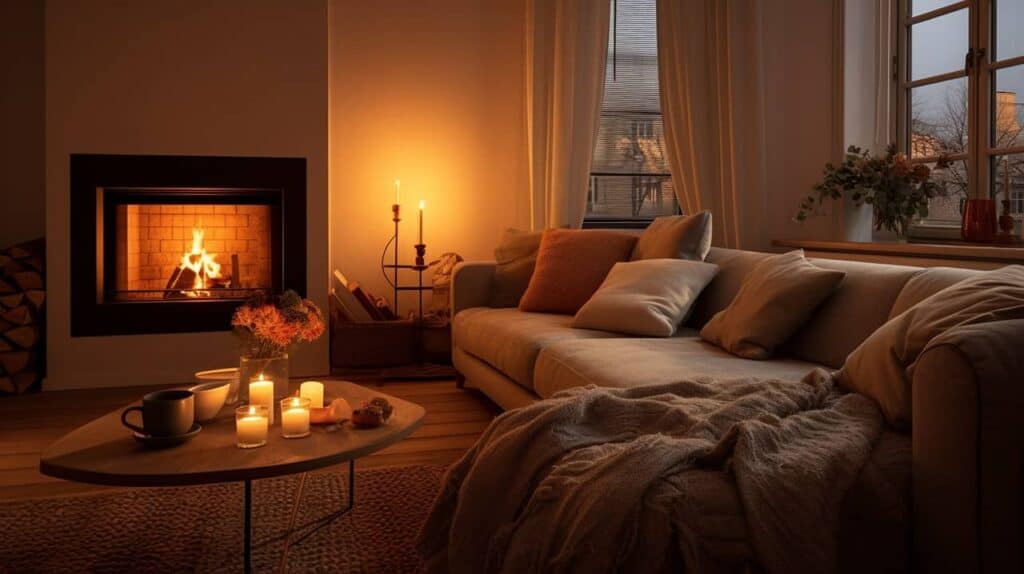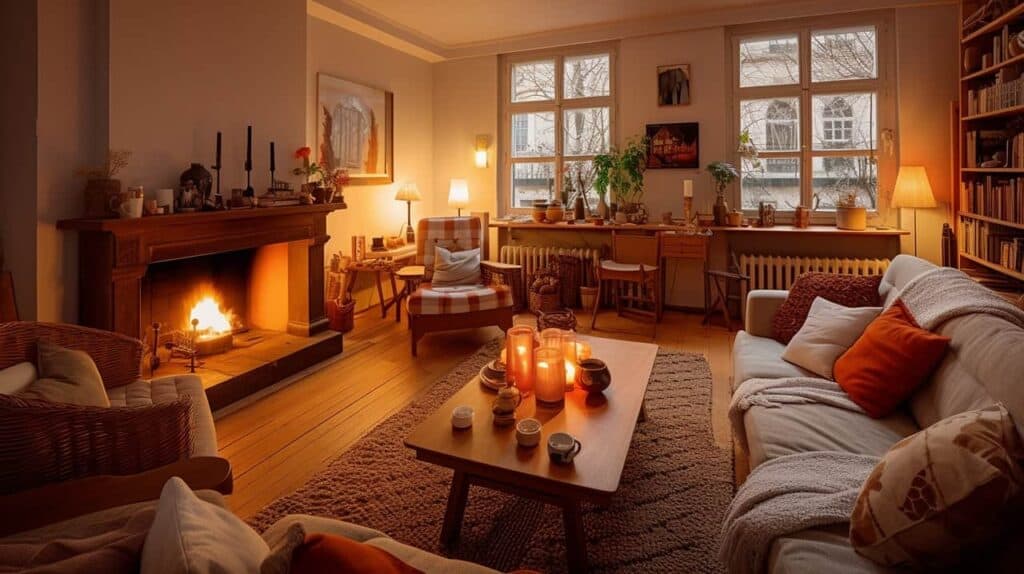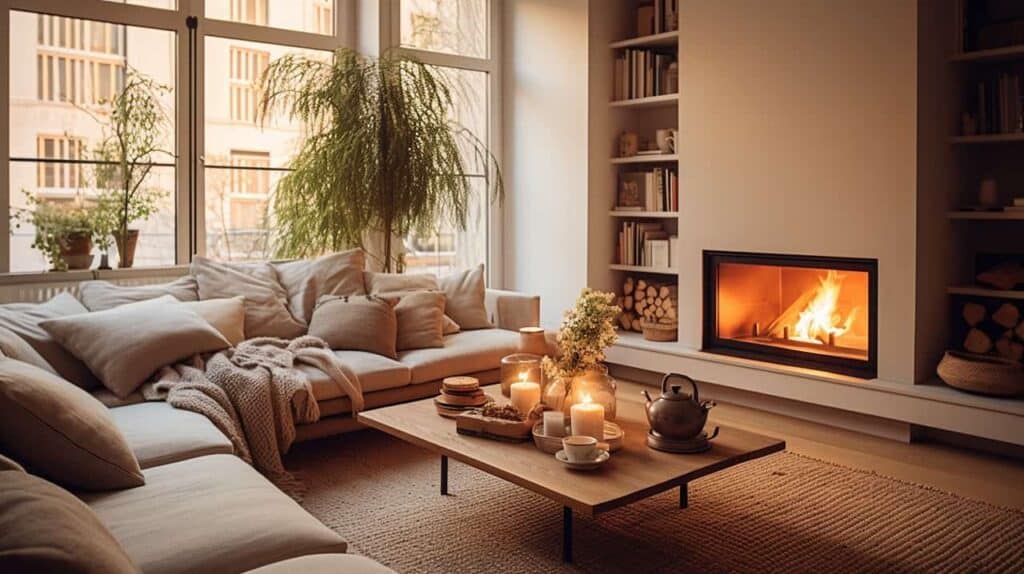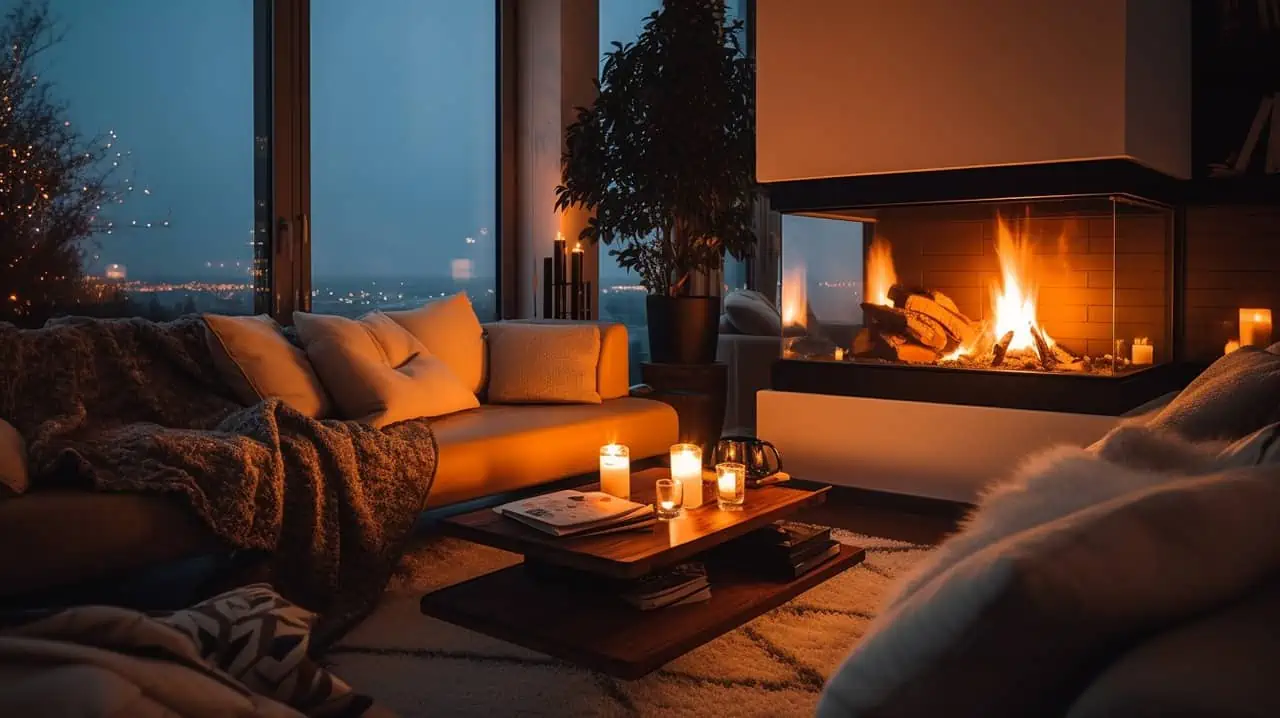Feeling the chill of winter seeping into your apartment? I’ve been there too, and it can be stressful when you have to brace yourself for an exorbitant heating bill every month. Did you know that even a small adjustment in thermostat settings can save 1% on energy bills, as stated by the Department of Energy? In this article, we’ll explore ten practical yet innovative tips for cutting costs without sacrificing warmth and comfort.
Ready for lower bills and a cozier home this winter? The following reducing energy bill tips can help you stay warm, stay safe, and not spend all your money on heating costs.
Key Takeaways
Lowering your thermostat by just one degree can lead to 1% savings on energy bills in an apartment.
Using space heaters strategically in walled-in rooms can effectively reduce heating costs.
Reversing the direction of your ceiling fan during winter months helps distribute heat evenly and allows you to lower the thermostat a few degrees without sacrificing comfort.
Sealing windows and doors for leaks, regular filter changes, and using window treatments like quilted curtains are effective ways to reduce heating expenses in an apartment.
Table of Contents
Understanding Heating Costs in an Apartment

Living in an apartment, we often find our energy bill skyrocketing during the winter months due to heating costs. It’s important to understand what contributes to these increased expenses – many of us tend to think that cranking up the heat is necessary for comfort.
In reality, however, the Department of Energy has found that by simply lowering your thermostat by one degree can lead up to 1 percent savings on your energy bills. Electric heaters are another common factor contributing towards high-energy consumption; while they’re extremely efficient and can be a great way to save on heating costs when used correctly.
Consideration should be taken about the size of both the space heater and room; appropriately using space heaters in walled-in rooms helps contain this warmth effectively without overloading their capacity.
Also, it’s recommended not just looking at traditional methods but also exploring innovative alternatives such as towel warmers which actually double down as mini-space heaters for bathrooms, or quilted curtains acting as draft blockers increasing overall comfort in chilly seasons.
Understanding these different aspects can empower you with control over your heating expenditures rather than feeling helpless every winter season.
Practical Ways to Reduce Heating Costs

Adjusting the thermostat to a lower temperature can lead to significant energy savings without sacrificing comfort.
Adjusting the Thermostat
Let’s talk about the thermostat, a small but mighty tool that can greatly influence your heating costs. The Department of Energy states that lowering your thermostat by one degree could save you 1 percent on your energy bill – so every notch counts! To maximize these savings in apartment living, consider investing in a smart or programmable thermostat.
These devices allow you to customize temperature settings for specific times and days. This way, when caught up in my daily routine or sleeping soundly at night, I’m not wasting heat and dollars unnecessarily.
Basically, with smart thermostats, I use less energy when it’s least needed and more during peak cold spells – an easy adjustment resulting in substantial savings over time.
Using Space Heaters Strategically
As the cold season sets in, power up your space heater to give your apartment a warm and cozy feel. But don’t just plug it anywhere! Carefully choose walled-in rooms where you’ll spend most of your time – like the living room or bedroom.
That way, heat gets contained effectively in these spaces without wasting energy heating rarely used areas in the apartment. Consider getting yourself an electric heater – they’re known for warming up rooms quickly and efficiently.
Remember to match the size of your heater with that of your room, as smaller rooms need lower wattage. The secret lies in strategic placement; proper usage can help slash those hefty winter heating bills significantly while also boosting comfort during frigid months.
Reversing Ceiling Fan Direction
In the winter months, reversing the direction of your ceiling fan can be a simple and effective way to lower heating costs in your apartment. By flipping the switch on your ceiling fan so that it spins clockwise instead of counterclockwise, you can force warm air down into the occupied space, helping to distribute heat evenly throughout the room.
This can reduce dependence on your central heating system and allow you to lower the thermostat by a few degrees without sacrificing comfort. In fact, according to the Department of Energy, lowering the thermostat by just one degree can save 1 percent on energy bills.
So take advantage of this easy trick and start saving on your heating expenses today!
Sealing Windows and Doors for Leaks
Sealing windows and doors is a crucial step in reducing heating costs in an apartment. Here are some effective ways to seal them:
- Inspect for gaps and cracks around windows and doors.
- Apply weather tape or draft seals to seal any air leaks.
- Replace old or damaged weather stripping on windows to improve energy efficiency.
- Use foam sealant to fill in gaps around window frames and door thresholds.
- Adjust or replace door sweeps to prevent under-the-door air leaks.
- Install plastic window treatments to create an additional barrier against drafts.
- Consider using aluminum foil on single-pane windows to reflect heat back into the room.
Regular Filter Changes
Regular filter changes can have a significant impact on reducing heating costs in your apartment. By replacing the filters in your HVAC system regularly, you ensure that it runs efficiently and effectively, saving energy and money.
Dirty filters can restrict airflow, causing your heating system to work harder and use more energy to maintain the desired temperature. By replacing these filters every 1-3 months, depending on usage and air quality, you can improve energy efficiency by up to 15% while also improving indoor air quality.
So make sure to add regular filter changes to your maintenance routine for maximum cost savings and comfort in your apartment.
Using Window Treatments Effectively
To effectively lower your heating expenses in an apartment, utilizing window treatments can make a significant difference. By using curtains or blinds, you can effectively block drafts and regulate the temperature in your space.
Quilted curtains are particularly effective at insulating windows and preventing cold air from seeping in during winter months. Applying window film kits can also improve energy efficiency by up to 70 percent.
These simple adjustments not only increase comfort but also help reduce heating costs in the long run.
Keeping Vents Clear and Dust-free
It’s important to keep your vents clear and dust-free to ensure efficient heating in your apartment. Dust and debris can accumulate in the vents, blocking airflow and reducing the effectiveness of your heating system.
By regularly cleaning and clearing out any dirt or dust from the vents, you can improve air circulation and maximize heat distribution throughout your living space. This simple maintenance task can help you save on heating costs by allowing warm air to flow freely without any obstacles.
Make it a habit to check and clean your vents periodically to keep them functioning optimally for better energy savings.
Innovative Methods to Save on Heating Costs
Using Quilted Curtains to Block Drafts
One effective way to lower heating expenses in an apartment is by using quilted curtains to block drafts. Quilted curtains can provide added insulation and help keep the cold air out, allowing you to lower the thermostat setting and save on energy bills. Here are a few tips for using quilted curtains effectively:
- Hang quilted curtains on windows that are prone to drafts. These curtains have an extra layer of insulation that can help keep the cold air from seeping into your apartment.
- Make sure the quilted curtains cover the entire window area. This will prevent any gaps where cold air could enter.
- Use curtain rods that extend beyond the window frame. This will allow you to pull the curtains fully closed, creating a barrier against drafts.
- Consider layering your quilted curtains with a sheer or lightweight fabric curtain during the day. This will allow natural light to enter while still providing some insulation.
- Keep your quilted curtains closed during colder periods of the day, such as at night or when you’re not home. This will help trap warm air inside and keep out drafts.
Applying Foam Sealant on Gaps
Foam sealant is an effective solution for sealing gaps in windows and doors, helping to reduce drafts and save on heating costs. Here’s how you can use foam sealant effectively:
- Identify the gaps: Inspect your windows and doors for any visible gaps or cracks where air may be leaking out.
- Clean the area: Before applying the foam sealant, make sure to clean the area around the gap to remove any dirt or debris.
- Shake the can: Give the can of foam sealant a good shake to ensure proper mixing of the components.
- Position the nozzle: Attach the nozzle provided with the foam sealant can to get a precise application.
- Start at one end: Begin applying the foam sealant at one end of the gap, moving along it in a steady motion.
- Fill in gaps completely: Ensure that you fill in all gaps completely with foam sealant, as even small openings can lead to significant heat loss.
- Smooth out excess foam: If there is any excess foam, use a putty knife or a similar tool to smooth it out evenly.
- Allow it to dry: Let the foam sealant dry according to manufacturer instructions before painting or adding any additional treatments.
- Test for effectiveness: After allowing it to dry, check if there are any remaining drafts by running your hand along the sealed area and feeling for cold spots.
- Reapply if necessary: If you still feel drafts after sealing with foam, reapply more sealant until all gaps are properly sealed.
Utilizing Towel Warmers
Using towel warmers can be a smart and efficient way to not only provide warm towels but also act as small space heaters in your apartment. Towel warmers are especially useful in bathrooms, where they can add a cozy touch while helping to reduce heating costs.
By turning on your towel warmer before taking a shower or bath, you can enjoy the luxury of wrapping yourself in a toasty towel afterward without relying solely on central heating.
This innovative method allows you to create warmth exactly where you need it, saving energy by not having to heat an entire room. So next time you want that extra bit of comfort during colder months, utilize your towel warmer for added warmth and savings on your heating bill.
Heating Rocks as a Natural Heat Source
One effective and natural way to lower your heating expenses in an apartment is by using heating rocks. Heating rocks can act as a cost-effective heat source, especially when placed strategically around the living space.
These rocks can absorb heat during the day and release it slowly throughout the night, keeping your apartment warm without relying heavily on central heating or electric heaters. By harnessing nature’s warmth, you can reduce your reliance on energy-consuming devices and save money on your winter heating bills.
Safety Precautions for Heating in an Apartment

When using space heaters in your apartment, never plug them into extension cords. Always use them directly into an outlet to prevent any electrical hazards and ensure the safety of your home.
Read More.
Never Plug Heaters into Extension Cords
It’s essential to never plug heaters into extension cords. Instead, always plug them directly into outlets to prevent overheating and potential fire hazards. According to important facts, electric heaters should not be used with extension cords as it can overload the circuits and cause electrical fires.
By plugging your heater directly into an outlet, you’ll ensure safe usage and reduce the risk of accidents or damages. So remember, when using a space heater in your apartment, always use a dedicated outlet for optimal safety.
Safe Use of Electric Heaters
I always prioritize safety when using electric heaters in my apartment. To ensure safe usage, I make sure to keep the heater at least 3 feet away from any flammable materials, such as curtains or furniture.
It’s also important to plug the heater directly into an outlet instead of using an extension cord, as this can prevent overheating and potential fire hazards. Additionally, I avoid using electric heaters while sleeping or leaving them unattended for long periods of time.
By following these precautions, I can enjoy the warmth and comfort of my electric heater without compromising on safety.
Importance of Space Heater Safety
It’s crucial to prioritize safety when using space heaters in your apartment. Keeping them at least 3 feet away from any flammable materials is essential to prevent fires or accidents.
Make sure to plug the heater directly into an outlet, avoiding extension cords that can overload and overheat. It’s also important not to use space heaters while sleeping, as this poses a significant risk of fire or other hazards.
Establishing a designated zone for your space heater and keeping it clear of any combustible objects is highly recommended for increased safety. By following these precautions, you can enjoy the warmth of a space heater without compromising on safety in your apartment.
Frequently Asked Questions About Lowering Your Heating Bill in an Apartment
What are some effective tips for lowering heating expenses in an apartment?
Some effective tips for lowering heating expenses in an apartment include setting the thermostat to a lower temperature, using draft stoppers or weatherstripping to seal windows and doors, insulating the apartment properly, using curtains or blinds to block cold drafts, and utilizing space heaters or electric blankets as needed.
How can I effectively insulate my apartment to reduce heating costs?
To effectively insulate your apartment and reduce heating costs, you can use weatherstripping tape around windows and doors, apply plastic film on windows to create an additional layer of insulation, add door sweeps to prevent drafts under doors, and use rugs or carpets on floors for added insulation.
Can closing vents in unused rooms help lower heating expenses?
Closing vents in unused rooms may help redistribute heat more efficiently throughout the apartment, but it might not significantly lower overall heating expenses. It is recommended to consult with a professional HVAC technician before closing vents as it could potentially disrupt the balance of the system.
Are there any alternative methods besides adjusting the thermostat that can help save on heating costs?
Yes, besides adjusting the thermostat temperature, you can also utilize natural sunlight by opening curtains during the day to let warmth in, dress warmly with layers while indoors, use ceiling fans on low settings during winter months (clockwise direction), and consider investing in energy-efficient appliances such as programmable thermostats or energy-saving heaters.
Conclusion

In conclusion, by implementing these 10 effective tips, you can significantly lower your heating expenses in an apartment. From adjusting the thermostat and strategically using space heaters to sealing windows and doors for leaks, every small step can make a big difference in reducing energy costs.
Remember to prioritize safety when using heating devices and explore innovative methods like quilted curtains or towel warmers. By taking these measures, you’ll not only save on your energy bill but also create a more comfortable living environment during the colder months.
So start applying these tips today and enjoy the benefits of lower heating expenses!



